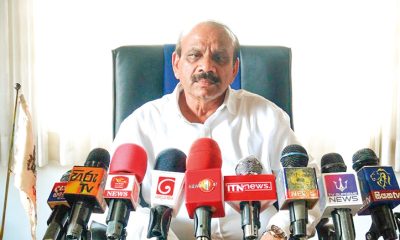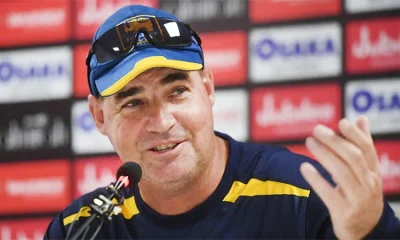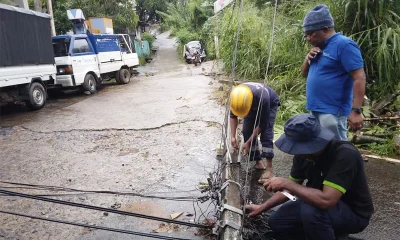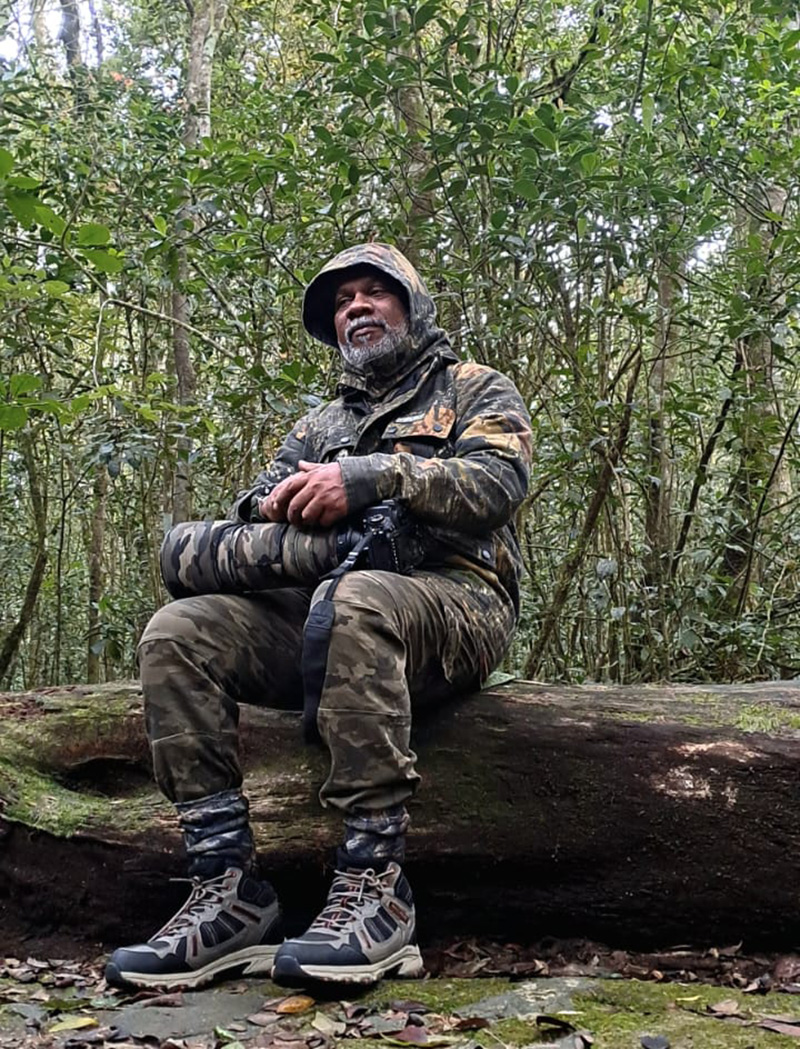Life style
Will these bills amplify women’s voices?

Women empowerment, gender and equality
Ambika Satkunanathan is a human rights advocate based in Sri Lanka. For more than twenty years she has worked with persons and communities impacted by human rights violations, and assisted them with accessing remedies. From Oct 2015 to March 2020, she was a Commissioner of the Human Rights Commission of Sri Lanka, where she led the first ever national study of prisons. Prior to that foreight years she was a Legal Advisor to the UN Office of the High Commissioner for Human Rights.
She is a board member of the UN Voluntary Trust Fund for Victims of Torture, a member of the Expert Panel of the Trial Watch Project of the Clooney Foundation and a member of the Network of Experts of the Global Initiative Against Transnational Organised Crime.
Her research, advocacy and activism have focused on counter-terrorism law and policy, drug control and rehabilitation, transitional justice, custodial violence, penal policy, militarization and gender. Her research on drug control, detention and rehabilitation in Sri Lanka, the first such study, was published in August 2021 by Harm Reduction International. She is currently working on recording the experiences of women who come into conflict with the law due to drug offences.
Her publications include contributions to the International Journal of Transitional Justice, the Oxford Handbook of Gender & Conflict, the Routledge Handbook on Human Rights in South Asia, Feminist Studies and Contemporary South Asia.
She is Chairperson of the Neelan Tiruchelvam Trust, a local grantmaking organisation in Sri Lanka and was a founder member and Vice Chairperson of Urgent Action Fund- Asia and Pacific, a feminist regional grantmaking organisation.
She was an Open Society Fellow from 2020-2022. She has a B.A. and LL.B from Monash University Australia and a LL.M from University of Nottingham, where she was a Chevening Scholar.
Could you tell us about you and some of the early influence in your life?
My experiences as a Tamil in Sri Lanka influenced the way I engaged with the world and drove me to work in human rights protection because I became aware of discrimination, violence and prejudice even as a child. As I grew older, as a woman, I experienced different forms of discrimination and prejudice that women generally face, which were worsened by my ethnic identity. This point at which both my identities intersected, and where I was exposed to the violent and ugly side of humanity is where what I believe something positive- my work, values and activism- were born.
Tell us about your most inspiring moments in your work so far?
In the kind of work I do, what I find most inspiring are the people that despite being subject to discrimination, loss, violence and pain, continue to struggle for their rights and that of others; those who continue to be humane despite the inhumane way in which the world has treated them.
What do your experience as the main challenge as someone working on human rights. And how do you deal with obstacles in your work?
The main challenge persons working on human rights protection face is the state/government viewing persons who work on human rights as enemies and threats to their power, and constantly trying to intimidate and/or discredit them and curtial and/or undermine their work.
The lack of viable, substantive and holistic remedies for persons who experience human rights violations is also a considerable challenge. Even the remedies that do exist, such as filing a fundamental rights petition in the Supreme Court or complaning to the Human Rights Commission of Sri Lanka can take months or even years, and even when a remedy is granted, it does not address all aspects of the violations experienced.
Not surprisingly, the various difficulties faced in supporting victims of human rights violations and assisting them to obtain remedies as well as challenging abusive state power can lead to feelings frustration or dejection. Personally, as a Tamil woman working on human rights I have often been labelled a terrorist, LTTE, anti-national, traitor and subject to gender-based online abuse, vilification and harassment.
One of the ways to deal with these obstacles is through collaborative work, partnerships and networks, and sharing resources. The other is long-overdue state reform, including reform of institutions such as the police. Human rights activists can advocate for such reform but it requires political will and progressive vision, which to date is sorely lacking in Sri Lanka. Another means is to step up and support those that are being attacked for the work they do or because of an aspect of their identity, such as LGBTIQ persons.
Your news on women empowerment bill, gender and equality Bill. Will these bills implement concrete actions to amplify women’s voices. There had been a national policy on women’s empowerment since 1911 your comments?
Many provisions of the Gender Equality Bill and the Women’s Empowerment Act give the appearance of sections of national action plans that have been turned into law. For instance, what is the purpose of making the appointment of focal points, which is an administrative function, a provision in a law? Furthermore, women’s groups and activists have stated they were not consulted on the gazetted version of the laws. Hence, the lawmaking process seems haphazard, was lacking in transparency and was not inclusive. The President’s remarks in parliament about the Supreme Court determination on the Gender Equality Bill where he stated that a parliamentary committee should be appointed to review the determination seems like an attempt to control judges and threatens the independence of the judiciary. Although the Suprene Court determination is problematic and not progressive, the executive undermining the independence of public institutions, particularly the judiciary, will only further erode the rule of law and democracy in Sri Lanka.
Enacting laws or establishing commissions or institutions will not magically lead to gender equality or women’s empowerment. To achieve gender equality, we need to acknowlege the patriarchal nature of Sri Lankan society and address misogyny, sexism and discrimination structurally and socially. This means we must address it in the family, school, universities, workplaces and particularly public institutions and systems.
Most importantly, do not forget that every right the government undermines, also undermines the rights of women and their safety and security. Every government attempt to undermine the rule of law, also adversely impacts women. Therefore, enacting these laws, while undermining the rule of law and public institutions and enabling violence by state entities, such as the police, is farcical and will only further undermine the rights, security and well-being of women.
Human rights remains a issue not only in Sri Lankan but all over the world. What is your assessment of the situation?
As you rightly say, human rights are under threat globally and the international legal order is being attacked and undermined. Sri Lanka is complicit in this as much as global powers, such as the US. What the detractors of the international legal order do not seem to understand or perhaps do not care about is that respecting the international legal order, international human rights standards and international processes, such as the UN processes, creates safety for all of us. Yet, the reality is that generally states do not like to be held accountable and go on the offensive when challenged, particularly in international fora as they feel being held accountable is a loss of face. States also weaponize human rights against certain countries and contexts and countries often point to other states that flout international law to justify their own violations. None of these positions are valid or viable. As I say, this is not a race to the bottom and you cannot claim the protections that international law affords only when it is expedient because then others will do the same and the result will be anarchy.
Specifically what are the main problem areas of human rights in Sri Lanka?
We have a government that does not respect the rule of law – for instance, police officers engaging in torture and the government and other state entities ignoring Supreme Court judgments and determinations is quite common. This further entrenches impunity and enables the government and state entities to abuse their power and continue to committ human rights violations. There is lack of trust in public institutions due to successive governments undermining their independence and policitising them.
Corruption is another critical issue that needs to be addressed. Repressive laws that do not adhere to international human rights standards, such as the Prevention of Terrorism Act, the Vagrants Ordinance, the Online Safety Act and provisions that criminalise same sex relations remain on the statute books.
Fifteen years after the end of the war a political solution to the ethnic conflict is elusive, and those responsible for war time violations have not been held accountable. Instead, war affected populations in the North and East, such as the families of the disappeared that demand truth and justice are surveilled, intimidated and harassed. This year families of those killed during the last stages of the war were not even allowed to hold ceremonies to remember the dead.
Socio-economic rights are also human rights- hence there are many violations that are taking place, including due to the economic crisis, such as the loss of livelihood, increasing poverty, malnutrition and reduced access to health care and education. The position of social groups that have been marginalised and discriminated against, such as persons with disabilities, LGBTIQ persons and Muslims and Malaiyaha communities remain largely unaddressed.
What are the main changes you like to see in the world particularly in relation to women and their rights?
I would like to see a world that is not patriarchal, sexist or misogynist- in which women do not have to constantly struggle to be seen, respected or heard. A world in which they are equal and have the choice to make decisions about their bodies and their lives, without being criminalised, abused, vilified, ridiculed or controlled.
ambikasat@gmail.com
Life style
What I Do, What I Love: A Life Shaped by Art, Wilderness and Truth

In a country where creative pursuits are often treated as indulgences rather than vocations, Saman Halloluwa’s journey stands apart — carved patiently through brushstrokes, framed through a camera lens, and articulated through the written word. Painter, wildlife and nature photographer, and independent environmental journalist, Halloluwa inhabits a rare space where art, ecology and social responsibility converge.
His relationship with art began not in galleries or exhibitions, but in a classroom. From his school days, drawing was not simply a subject but an instinct — a language through which he learned to observe, interpret and respond to the world around him. Under the guidance of two dedicated mentors, Ariyaratne Guru Mahathaya and Gunathilaka Guru Mahathaya, he honed both skill and discipline. Those early lessons laid the foundation for a lifelong engagement with visual storytelling.

“His work navigates between traditional Sinhala artistic sensibilities, abstract compositions and expansive landscapes.”
 That commitment eventually materialised in two solo art exhibitions. The first, held in 2012, marked his formal entry into Sri Lanka’s art scene. The second, staged in Colombo in 2024, was a more mature statement — both in content and confidence. Featuring nearly fifty paintings, the exhibition drew an encouraging public response and reaffirmed his place as an artist with a distinct visual voice.
That commitment eventually materialised in two solo art exhibitions. The first, held in 2012, marked his formal entry into Sri Lanka’s art scene. The second, staged in Colombo in 2024, was a more mature statement — both in content and confidence. Featuring nearly fifty paintings, the exhibition drew an encouraging public response and reaffirmed his place as an artist with a distinct visual voice.
His work navigates between traditional Sinhala artistic sensibilities, abstract compositions and expansive landscapes. There is restraint in his use of form and colour, and an underlying dialogue between memory and space. Yet, despite positive reception, Halloluwa speaks candidly about the structural challenges faced by artists in Sri Lanka. Recognition remains limited; fair valuation even rarer.
“This is not merely an artistic issue,” he observes. “It is a social and economic problem.”
In Sri Lanka, art is often viewed through the lens of affordability rather than artistic merit. Many approach a painting by first calculating the contents of their wallet, not the value of the idea or labour behind it. In contrast, he notes, art in Europe and many other regions is treated as cultural capital — an investment in identity, history and thought. Until this mindset shifts, local artists will continue to struggle for sustainability.
The decisive push toward wildlife photography came from Professor Pujitha Wickramasinghe, a close friend who recognised both Halloluwa’s observational skills and his affinity with nature. From there, the journey deepened under the mentorship of senior wildlife photographer Ravindra Siriwardena.
Both mentors, he insists, deserve acknowledgment not merely as teachers but as ethical compasses. In a field increasingly driven by competition and spectacle, such grounding is invaluable.
Wildlife photography, Halloluwa argues, is among the most demanding visual disciplines. It cannot be improvised or rushed. “This is an art that demands restraint,” he says.
Among all subjects, elephants hold a special place in his work. Photographing elephants is not merely about proximity or scale, but about understanding behaviour. Observing social patterns, movement, mood and interaction transforms elephant photography into a constantly evolving challenge. It is precisely this complexity that draws him repeatedly to them.
Halloluwa is cautiously optimistic about the current surge of interest in wildlife photography among Sri Lankan youth. Opportunities have expanded, with local and international competitions, exhibitions and platforms becoming more accessible. However, he issues a clear warning: passion alone is not enough
Sri Lanka, he believes, is uniquely positioned in the global nature photography landscape. Few countries offer such concentrated biodiversity within a compact geographical area. This privilege, however, carries responsibility. Nature photography should not merely aestheticise wildlife, but foster respect, aware ness and conservation.
Parallel to his visual work runs another equally significant pursuit — environmental journalism. For the past seven to eight years, Halloluwa has worked as an independent environmental journalist, giving voice to ecological issues often sidelined in mainstream discourse. His entry into the field was guided by Thusara Gunaratne, whose encouragement he acknowledges with gratitude.
An old boy of D.S. Senanayake College, Colombo, Halloluwa holds a Diploma in Writing and Journalism from the University of Sri Jayewardenepura and has completed journalism studies at the Sri Lanka Press Institute. He is currently pursuing an Advanced Certificate in Wildlife Management and Conservation at the Open University of Sri Lanka — a testament to his belief that learning must remain continuous, especially in a rapidly changing ecological landscape.
Outside his professional life, he enjoys cricket, rugby and badminton. Yet even leisure intersects with responsibility. He is a founding member and former president of the D.S. Senanayake College Old Boys’ Wildlife Forum, an active member of Wild Tuskers Sri Lanka, and a contributor to several independent environmental and wildlife volunteer organisations. In an era dominated by speed, spectacle and short attention spans, Saman Halloluwa’s journey unfolds differently. It is deliberate, reflective and rooted in values. Through art, he captures memory and form. Through photography, he frames life beyond human control. Through journalism, he asks uncomfortable but necessary questions.
“What I do, what I love” is not fashion here.
It is conviction — patiently lived, quietly asserted, and urgently needed in a country still learning how to value its artists, its environment and its truth.
By Ifham Nizam ✍️
Life style
Shaping the future of style

Ramani Fernando Sunsilk Hair and Beauty Academy
Ramani Fernando Sunsilk Hair and Beauty Academy marked their graduation of their latest cohort of aspiring hair professionals in a ceremony held at Kingsbury Hotel.
For over two decades, the Ramani Fernando Sunsilk Hair and Beauty Academy has stood as a beacon of excellence in beauty education in Sri Lanka. Founded by industry icon Ramani Fernando, the Academy has built a reputation for producing highly skilled professionals who go on to make their mark in salons, both locally and internationally. As the newly minted graduates step out into the world, they carry forward not just certificates, but also the promise of creative authority and personal empowerment.
The chief guest for the occasion was Rosy Senanayake, a long-standing supporter of the Academy’s mission. Addressing the graduates her message echoed her enduring belief that the beauty industry is not merely about aesthetic but about. confidence, self-worth and future leaders.
Over months of rigorous training, these young professionals honed their skills in cutting colouring, styling and contemporary artistry readying themselves to set trends rather than follow them.
Each graduate walked the stage with confidence, their dedication signalling a promising future for Sri Lanka’s beauty and fashion industry! With this new generation of stylists preparing to raise the standard of professional hairstyling.
Ramani Fernando, addressing the audience reflected on the academy’s mission to cultivate not only skills but vision and confidence in every student.
She urged the graduates to embrace continuous learning to take risks with creativity .The world of beauty is ever evolving, stay curious, stay bold and never underestimate the power of your talent, she added emphasising the importance of confidence, discipline and passion in carving a successful career in shaping the future of style.
These graduates are stepping into a world of endless possibilities. They are future of the country, who will carry a forward legacy of creativity. Behind every successful graduate at Sun silk Hair Academy stands a team dedicated to excellence. While Ramani Fernando serves as a visionary Principal and it is Lucky Lenagala, her trusted person who ensures that the academy runs seemingly.
From overseeing training sessions to guiding students, through hands on practice, Lucky plays a pivotal role in shaping the next generation of hairstylists.
Kumara de Silva, who has been the official compere Ramani’s, Hair graduation ceremony, from inception has brought energy, poise and professionalism. The Sunsilk Hair Academy is a celebration of talent and mentor ship for the graduates stepping confidentially into the next chapter of their careers, ready to make their mark on Sri Lanka beauty landscape
Pix by Thushara Attapathu
By Zanita Careem ✍️
Life style
Capturing the spirit of Christmas

During this season, Romesh Atapattu’s Capello Salon buzzes with a unique energy – a blend of festive excitement and elegance. Clients arrive with visions of holiday parties, office soirees, seeking looks that capture both glamour and individuality. The salon itself mirrors this celebrity mood. Warm lights, tasteful festive décor create an atmosphere where beauty and confidence flourish.
Romesh Atapattu himself curates the festive décor, infusing the space with his signature sense of style. His personal eye ensures that the décor complements the salon’s modern interiors.
As Colombo slips effortlessly into its most glamorous time of year, the Christmas season brings with it more than twinkling lights and celebrity soirees – it signals a transformation season at salons across the city. Capello salons are no exception.
At the heart of this festive beauty movement is Romesh Atapattu of Capello salons, a name synonymous with refined hair artistry, modern elegance and personalised style.
Christmas is about confidence and celebration. Romesh believes ‘People want to look their best without losing who they are”. Our role is to enhance, not overpower. This philosophy is evident in the salon’s seasonal approach.
Beyond trends, what sets Atapattu apart is the attention to individuality. Each consultation is treated as a creative collaboration – face shape, lifestyle, hair texture and personal style all play a role in creating the best for Romesh.
Stepping into Romesh’s salon during the Christmas season is an experience in itself. The space hums with festive energy while maintaining an atmosphere of calm sophistication.
The décor embraces the Christmas spirit with understated elegance. Tastefully adorned décor, beautiful Xmas tree, soft gold and ivory tones, and gentle hints of red are woven seamlessly into the salon’s contemporary design.
His staff, known for their warmth and professionalism also plays a key role in shaping the salon’s atmosphere—friendly, stylish and always welcoming. The Capello staff combine skill and creativity to deliver results that have a lasting impression.
Beyond trends, what sets Romesh Atapattu apart is the attention to individuality. Each consultation is treated as a creative collaboration – face shape, lifestyle, hair texture and personal style all play a role.
He is a professional who blends technical mastery with a deeply personal approach to style. His dedicated team of skilled professionals, operate with quiet confidence ensuring styles that create an atmosphere of trust, turning every appointment into a personalised and memorable experience.
(ZC) ✍️
Pic by Rohan Herath
-

 News7 days ago
News7 days agoBritish MP calls on Foreign Secretary to expand sanction package against ‘Sri Lankan war criminals’
-

 News6 days ago
News6 days agoStreet vendors banned from Kandy City
-

 Sports7 days ago
Sports7 days agoChief selector’s remarks disappointing says Mickey Arthur
-

 Opinion7 days ago
Opinion7 days agoDisasters do not destroy nations; the refusal to change does
-

 Sports3 days ago
Sports3 days agoGurusinha’s Boxing Day hundred celebrated in Melbourne
-

 News6 days ago
News6 days agoLankan aircrew fly daring UN Medevac in hostile conditions in Africa
-

 News23 hours ago
News23 hours agoLeading the Nation’s Connectivity Recovery Amid Unprecedented Challenges
-

 Sports4 days ago
Sports4 days agoTime to close the Dickwella chapter




















